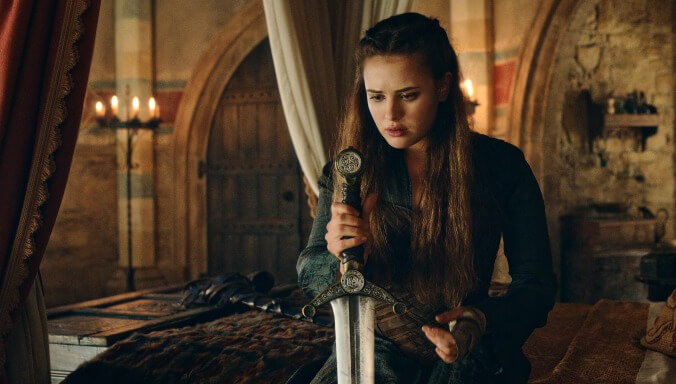Netflix’s Cursed delivers enchantment and magic misfires in equal measure


Legends are meant to be left to interpretation, used for lessons and applications to real-life situations. “What if” is a common question that arises when exploring these legends, and that’s what Frank Miller and Tom Wheeler sought to analyze and bring to life with their Cursed novel. Re-imagining Arthurian legend to center on the female characters that had long been used as side characters and devices to further the plot is a heavy task for a book, but even more so for a TV adaptation. A novel does not have the constraints of time and length that a streaming series does to capture the viewer. This is where Cursed season one may have cast a spell with minimal effect: It’s occasionally enchanting, if often confused about what plot it’s following at any given time.
Cursed takes the legend of Arthur and flips the widely known stories to center Nimue (13 Reasons Why’s Katherine Langford), or as she’s more commonly known, the Lady Of The Lake. Nimue’s story is as tragic as it is magical: Within Arthurian legend, Nimue is the lover of Merlin, adoptive mother of Lancelot, and bequeather of Excalibur to Arthur. In Wheeler and Miller’s version, Nimue is still destined to be the Lady Of The Lake; however, before reaching that fate, she teams up with mercenary Arthur, portrayed by Devon Terrell (Barry), and Sister Igraine/Morgana, beautifully interpreted by Shalom Brune-Franklin (Bad Mothers), to save the Fey folk that had cast her out. Langford, fresh off Knives Out, tackles the role of Nimue with quiet tenacity, approaching the pacing of the script head-on, making up on occasion for the stalls in scenes where pauses are prevalent. Nimue’s desire to not succumb to the dark magic she has been marked with from childhood distinguishes her from other portrayals of the character, particularly the iteration in Once Upon A Time, which embraced her dark side. This retelling makes it clear Nimue wants to do right by her people and escape her fate.
The story starts in the middle of a war waged by the Church: The Red Paladins fight against all Fey kind as well as any non-magical humans who show empathy to the Fey (and aren’t followers of the Church). When the Red Paladins and their infamous Weeping Monk (Daniel Sharman) lay siege to her village, Nimue manages to escape with one task: Take an ancient sword, find Merlin, and deliver it to him. Merlin, played by Gustaf Skarsgård (Westworld), is depicted as a fallen “angel” with a hint of Captain Jack Sparrow. This unfortunately only works about two-thirds of the time, though Merlin’s interactions with Uther Pendragon (Harlots’ Sebastian Armesto), deliver some of the show’s best moments, as the contentious tone between the two quickens the pace of the show.
In true Miller fashion, there is heavy use of violence and gore. We encounter other Miller film favorites as well, including crudely-sewn eyes and mutilated hands. The use of animated transitions confuses the timeline and placement of scenes, which—along with ongoing pacing issues—can take the viewer out of the fantasy world. While the novel is able to seamlessly make time jumps and take the reader forward and backward in the story, those moves do not translate well on screen. For example, the novel begins in the middle of Nimue’s village being sieged by the Red Paladins, and then takes a leap to before the siege. The first episode begins before the siege and utilizes numerous animations for the transition leading up to the raid, but this technique doesn’t achieve the same effect.
The agency given to the women that populate this fantasy world is one of Cursed’s redeeming qualities, which is another prominent mark of Miller’s work. From Sin City to his Marvel creation Elektra, women are positioned as their own heroes and men are relegated to the sidelines. The matriarch is clearly centered and positioned in power in the show. Nimue is meant to propel the story forward, and the other female characters within the show, whether benevolent or malevolent, all stand out against the patriarchy that has long been associated with Arthurian legend. Through Cursed, Wheeler and Miller tackle a very relevant conversation within the medieval context.
The fantasy drama is also refreshing for its diverse casting in not just background and supporting characters, but lead roles as well. Still, Cursed suffers from what remains a widespread industry issue: The lack of a key hairstylist trained in Black hair to help oversee styling. This is a particularly frustrating aspect of the show because many of the non-Black/POC actors’ hairstyles are intricately crafted to embody the period and spirit of their characters. While the costumes take this adaptation beyond other shows in the genre, it would’ve catapulted to another level with hairstyling that was uniform in its quality. What is a heartening development is the lighting throughout, which manages to capture the many different skin tones that appear on screen, something that has been an issue for other high-fantasy shows.
Given the saturation of the high-fantasy genre in recent years, this could feel like another lobster in the proverbial pot, climbing its way to be on top. What gives Cursed its edge is the source material, which subverts centuries of lore and oppressive systems. The Netflix adaptation isn’t nearly as captivating, but it still manages to be a quaint escape from reality.